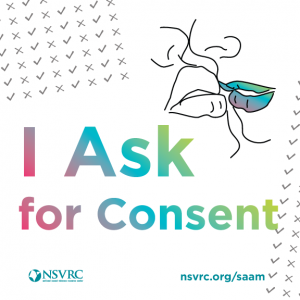“Hey, do you have a minute”
“Wonderful! I was hoping we could talk about consent, either now or at a time that is more convenient for you. Is that a conversation that interests you?”
Although this post is being released during Sexual Assault Awareness Month, the primary focus is not on consent from a legal perspective or the causes and consequences of sexual violence. It is an invitation to explore the concept of consent within all areas of your life, in addition to that of healthy sexuality. It is about heightening our awareness, individually and collectively, of the way consent underlies and permeates many, perhaps all, of our interactions.
This conversation is meant to open your eyes to how influential consent is during both profound, life-changing moments, as well as during mundane exchanges. It is about understanding that the navigation of consent is a skill set, which can and should be practiced intentionally.
In the broadest terms, consent is giving or granting another person, or other people permission. Ultimately, it is about respecting boundaries, preferences, and desires.
Do you have any apps on your phone? If so, it is likely that you have given multiple companies consent to access your location, contacts, and photographs. Have you ever clicked a box that granted permission for a company to use your images in marketing or promotion? Individuals engage in dialogue around consent, but organizations, and nations do as well.
Culturally, we have been moving toward granting consent more freely, more cavalierly. What was at one time considered fairly private information, reserved for one-on-one conversations with a few trusted and close friends, is now posted to public forums and social media. People regularly accept collection and use of personal information and tracking of virtual behavior without a second thought. They may be giving blanket consent without realizing the implications.
When letting a sexual partner take a nude photo, someone is consenting to that person, and only that person, viewing the photo later. The consent does not extend to their emailing it to peers or posting it publicly online. Distribution of the photos to others sometimes referred to as revenge porn, is beyond the scope of the original consent. Likewise, organizations should not assume blanket consent. When giving a company permission to use your data, do you check the user agreement to verify whether the information is being collected strictly to improve the platform? Or are you unknowingly consenting to it being sold to other companies?
Larger cultural shifts with respect to privacy and personal boundaries impact our perceptions and our social interactions in a variety of ways.
Navigating Boundaries
With respect to physical contact, consent is about autonomy. Only I have the right to decide who can touch me, when I will be touched, and in what ways I will be touched. We see physical boundaries negotiated, respected, and violated all the time. Physical boundaries are negotiated with family, colleagues, even strangers.
A stranger may initiate a boundary negotiation by standing, or driving, too close. If someone feels the person behind is driving too close, they might speed up to create more distance, slow down to heighten the awareness of the other driver, or change lanes to resolve the situation. If this negotiation is not handled respectfully, it might lead to angry words, gestures, or violence. There are a multitude of reasons why strangers end up in negotiations over physical space. In part, because people have different assumptions, preferences, and rules of etiquette. What one considers an appropriate distance to follow, another may consider rude or inappropriate.
Power differentials add layers of complexity when granting permission among colleagues. Employees might feel pressure to allow things beyond their comfort zone due to actual or implied influence over performance evaluation, retention, or advancement opportunities. After reaching an agreement on price, a seller extends a hand to seal the deal. The buyer reaches past the hand and pulls the seller into a hug. Given the power differential, was this a violation of the seller’s physical boundaries? Colleagues not only negotiate physical boundaries whenever they greet one another with a handshake or hug but also when they are deciding the configuration of office furniture.
Some professions require physical contact. A dentist, for example, might touch the inside of someone’s mouth almost immediately following an introduction. Paramedics might touch an unconscious person prior to introduction. As our understanding of consent has expanded culturally, health care professionals have reassessed notions about obtaining permission.
How does a patient/client give consent? The first step is to ask a question such as: “Mr. Brown, is it OK if I check your blood pressure now?”
The following responses are considered as offering consent:
- The patient saying “yes” or something similar (“all right”, “OK”, etc.).
- The patient nodding assent.
- The patient rolling their sleeve up to receive the cuff.
adapted from First Steps for Health Care Assistants, “Consent,” Royal College of Nursing
When people work in professions that regularly involve intimate touching, they are often trained to be very clear in expressing the details surrounding what they are about to do and why. These types of conversations are intended to alleviate awkwardness and nervousness patients sometimes experience by setting a tone of professionalism. Reducing or eliminating surprises clears up confusion and ambiguity.
Within families, parents might insist children accept hugs from relatives or allow their hair to be disheveled, even though they have no desire to tolerate these things. Their discomfort, resistance, and potential embarrassment are dismissed, pushed aside without regard. They are stripped of their autonomy with respect to their own bodies. They are denied the ability to decide for themselves who touches them and in what ways.
Consent is not just about sexual intimacy, it is about navigating boundaries as we interact throughout our daily lives. Re-framing how we approach consent, in practice, requires addressing our preconceived notions about boundaries, desires, autonomy, and privacy. Our perception of consent begins in early childhood and is modified, expanded, and sometimes re-written as we move into adulthood. The assumptions we have around consent, particularly those that were part of our early childhood socialization, may affect our professional lives, as well as relationships with friends, family, and romantic or intimate partners.
“Thank you for joining me for this conversation. I hope that moving forward you take time to think about, talk about, and ASK for consent!”
Read part two about communicating consent inside and around the bedroom.


